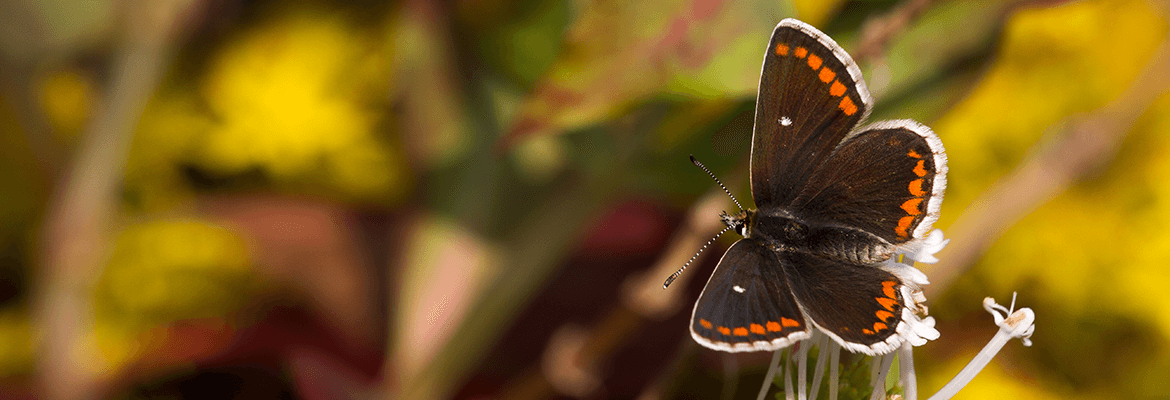
Wingspan
25 - 31 mm
Checklist Number
61.016
For many years, the Northern Brown Argus was considered to be a subspecies of the Brown Argus. However, it is now believed that this is a distinct species in its own right and has a different flight time and different number of broods - this species being single-brooded. Although very similar in appearance to a Brown Argus, the two can be separated by location in the British Isles, since the Northern Brown Argus is found only in the north of England and Scotland. This species exists as 2 distinct subspecies that are endemic to the British Isles, the result of being separated from its continental cousins for thousands of generations. The artaxerxes subspecies is found in Scotland and the Salmacis subspecies in northern England. Small populations may occur in Clwyd, North Wales, although these may turn out to be colonies of Brown Argus. This butterfly is not found on the Isle of Man. Most colonies are small, containing less than 50 adults.
This species was first defined in Fabricius (1793) as shown here (type locality: England).
The nominate subspecies is characterised by the white spot found on the forewing upperside, and is found only in Scotland.
This subspecies was first defined in Stephens (1828b) as shown here (type locality: Castle Eden Dene, County Durham, England).
This subspecies represents the population found in northern England, in a band that runs between Westmorland and Mid-west Yorkshire in the west to Durham in the east. When compared with the subspecies artaxerxes, this subspecies has greatly reduced, sometimes absent, white spots on the forewings. This subspecies is also known as the Castle Eden Argus.
Original (English and Latin)
From whom [G.Wailes, Esq.] I have also recently obtained specimens of what seems to be a new species of Polyommatus, intermediate between Po. Agestis and Artaxerxes, and which I propose calling Po. Salmacis, thus briefly characterised:-
Po. Salmacis. Alis fusco-nigris, subtus fuscescentibus maculis subocellatis, anticis supra in masculis puncto discoidali atro, in faeminis albo, posticis utrinque fascia submarginali rubra. (Exp. alar. [Male] 1 unc. 1 lin.; [Female] 1 unc. 2 lin.)
"Taken on Castle Eden Dean." - G.Wailes, Esq.
Translation
From whom [G.Wailes, Esq.] I have also recently obtained specimens of what seems to be a new species of Polyommatus, intermediate between Po. Agestis and Artaxerxes, and which I propose calling Po. Salmacis, thus briefly characterised:-
Po. Salmacis. Wings brownish black, with darkish eye-like spots beneath, with a black discoidal spot in the male on the forewing upperside, white in the female, the hindwing on both sides having a red submarginal band. (Wingspan ♂ 1 inch 1 line; ♀ 1 inch 2 lines)
"Taken on Castle Eden Dean." - G.Wailes, Esq.
| Family: | Lycaenidae | Leach, 1815 |
| Subfamily: | Polyommatinae | Swainson, 1827 |
| Tribe: | Polyommatini | Swainson, 1827 |
| Genus: | Aricia | Reichenbach, 1817 |
| Subgenus: | ||
| Species: | artaxerxes | (Fabricius, 1793) |
| Subspecies: | artaxerxes | (Fabricius, 1793) |
| salmacis | (Stephens, 1828) |
Description to be completed.
The distribution data (2000-2009) has been made available through the generosity of Butterfly Conservation and any subspecies distribution is taken from Riley (2007). Click here to see the distribution of this species together with site information overlaid.
This species is found on sheltered south-facing slopes, or in hollows. Alkaline ground, such as limestone, is preferred since this favours the growth of the larval foodplant, Common Rock-rose. This butterfly can be found on limestone grassland, coastal valleys and quarries, limestone pavement and outcrops.
Population levels of this butterfly have shown an ongoing decline, primarily caused by inappropriate grazing and, in Scotland, loss of suitable habitat to tree plantations. This butterfly is therefore a priority species for conservation efforts.
The table below shows the occurrence (distribution) and abundance (population) trends, using information from The State of the UK's Butterflies 2015 (Fox, 2015). Any UK BAP status is taken from the UK Biodiversity Action Plan (UK BAP) (2007 review).
1976-2014 (%) | 1976-2014 (%) | 2005-2014 (%) | 2005-2014 (%) | Click here to access the Biodiversity Action Plan (BAP). |  -27 -27 |  -52 -52 |  -36 -36 |  +6 +6 |
|---|
This species has a single brood. Adults emerge in early June, peaking at the end of June, except in north-east Scotland, where adults emerge toward the end of June, peaking in the middle of July.


This is a warmth-loving species, with both male and female flying in warm sunshine. Both sexes roost head-down on a grass stem and, like the Brown Argus and Common Blue, roost communally.
Adults feed primarily on Bell Heather (Erica cinerea), brambles (Rubus spp.), Common Bird's-foot-trefoil (Lotus corniculatus), Kidney Vetch (Anthyllis vulneraria), knapweeds (Centaurea spp.), ragworts (Jacobaea spp.), Red Clover (Trifolium pratense), Red Valerian (Centranthus ruber), Small Scabious (Scabiosa columbaria), thistles (Carduus spp. and Cirsium spp.) and Wild Thyme (Thymus polytrichus).
The larva hibernates in the 3rd instar and there are 4 moults in total. It is occasionally tended by ants.
The primary larval foodplant is Common Rock-rose (Helianthemum nummularium).
Description to be completed.
Description to be completed.
Description to be completed.
Description to be completed.
Description to be completed.
The following links provide additional information on this butterfly.